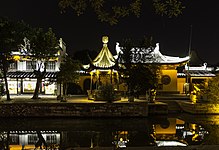Guanghui Palace
Appearance
| Guanghui Palace | |
|---|---|
广惠宫 | |
 Guanghui Palace | |
| Religion | |
| Affiliation | Taoism |
| Location | |
| Location | Nanxun, Huzhou, Zhejiang |
| Country | China |
| Geographic coordinates | 30°52′33.81″N 120°25′34.74″E / 30.8760583°N 120.4263167°E |
| Architecture | |
| Style | Chinese architecture |
| Date established | 1064–1067 |
| Completed | 2003 (reconstruction) |
Guanghui Palace (simplified Chinese: 广惠宫; traditional Chinese: 廣惠宮; pinyin: Guǎnghuì Gōng), commonly known as Zhang–Wang Temple (张王庙; 張王廟; Zhāng–Wáng Miào), is a Taoist temple located in Nanxun of Huzhou, Zhejiang, China.[1]
History
[edit]The temple was first established in the reign of Yingzong of the Northern Song dynasty (960–1127). In late Yuan dynasty (1271–1368), Zhang Shicheng used the temple as his Xinggong (Chinese: 行宫; lit. 'imperial palace for short stays away from the capital'). It has been burned down and rebuilt several times, due wars and natural disasters. The current temple was rebuilt in 2003.[2]
Architecture
[edit]The statues of Three Pure Ones are enshrined in the main hall of the temple.[2]
References
[edit]- ^ 浙江这座藏在古镇里的道观,曾三毁三建,迄今已有上千年历史 [The Taoist temple in the ancient town, once was burned and rededicated three times, has a history of thousands of years]. 163.com (in Chinese). 2018-10-03.
- ^ a b 广惠宫 [Guanghui Palace]. huzhou.gov.cn (in Chinese). 2013-06-20. Archived from the original on 2019-04-06. Retrieved 2019-04-06.

